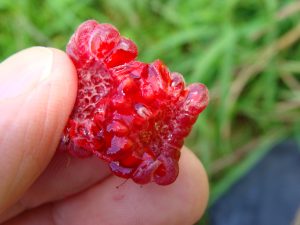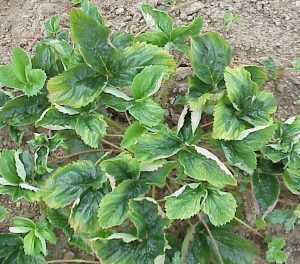Spotted Wing Drosophila Alert and Berry Notes — July 26, 2024
David Handley, Vegetable and Small Fruit Specialist; James Dill, Pest Management Specialist, Phil Fanning, Assistant Professor of Agricultural Entomology, Christina Howard, Maine New Farmer Project Manager

Spotted Wing Drosophila:
Fly counts in our vinegar/yeast traps were high enough to warrant protective sprays to all ripening berry and soft fruit crops to protect against infestation. I have found larvae feeding in raspberries, blueberries and honeysuckle this week. The presence of any larvae in ripening fruit should initiate a regular spray program to prevent further infestation. When 6 to 10 flies are caught in a yeast-baited trap in a week, larvae will start appearing in the fruit. This week counts have been ranging from 8 to 234 in our traps, indicating that ripening fruit needs protection to prevent infestation.
Populations will climb in the coming weeks as more food becomes available. Start sprays on any berries that have begun to ripen when more than four spotted wing drosophila flies are caught in a trap, or any larvae are noticed in the fruit. Look for fruit flies hovering around fruit and symptoms of premature fruit decay. At this point a 7-day interval of sprays should be adequate to minimize fruit infestation, but as populations continue to build, a shorter interval may be required.
For more information on identifying spotted wing drosophila (SWD) and updates on populations around the state, visit our SWD blog.
Berry Notes:
- I continue to get reports of Japanese beetles in very high numbers infesting raspberries, blueberries and grapes. Several of same products for controlling spotted wing drosophila will also provide control of Japanese beetles including Mustang Maxx® and Brigade®.
- Blueberry growers should continue to keep an eye out for Anthracnose fruit rot. The weather has been very conducive for this fungus. Infected berries soften and collapse. Small orange dots will develop on the fruit surface, which are the spores. These will be spread onto healthy fruit through rain splashing and dripping. Pristine®, Switch® and Captan® offer good control of anthracnose.
-

Leafhopper Burn, photo by David Handley Potato leafhoppers have been causing damage on strawberries and raspberries over the past two weeks. Leaves and new shoots can look twisted, and streaked with yellow and may turn necrotic. Look for the small, bright green nymphs on the undersides of the leaves. Suggested materials for control depend on which crop is infested. Check the New England Small Fruit Management Guide for recommendations.
Other IPM Web Pages
Michigan State University Spotted Wing Drosophila
Penn State University Spotted Wing Drosophila Overview
University of New Hampshire SWD Weekly IPM Reports
David T. Handley
Vegetable and Small Fruit Specialist
Highmoor Farm
P.O. Box 179
Monmouth, ME 04259
207.933.2100
UMaine Extension Diagnostic Research Lab
Pest Management Unit
17 Godfrey Drive
Orono, ME 04473
1.800.287.0279
| Town | Spotted Wing Drosophila weekly trap catch 7/25/24 |
|---|---|
| Wells | 46 |
| Sanford | 64 |
| Limington | 40 |
| New Gloucester | 234 |
| Mechanic Falls | 11 |
| Monmouth | 75 |
| Wayne | 8 |
Where brand names or company names are used it is for the reader’s information. No endorsement is implied nor is any discrimination intended against other products with similar ingredients. Always consult product labels for rates, application instructions and safety precautions. Users of these products assume all associated risks.
In complying with the letter and spirit of applicable laws and pursuing its own goals of diversity, the University of Maine System does not discriminate on the grounds of race, color, religion, sex, sexual orientation, transgender status, gender, gender identity or expression, ethnicity, national origin, citizenship status, familial status, ancestry, age, disability physical or mental, genetic information, or veterans or military status in employment, education, and all other programs and activities. The University provides reasonable accommodations to qualified individuals with disabilities upon request. The following person has been designated to handle inquiries regarding non-discrimination policies: Director of Equal Opportunity, 5713 Chadbourne Hall, Room 412, University of Maine, Orono, ME 04469-5713, 207.581.1226, TTY 711 (Maine Relay System).
